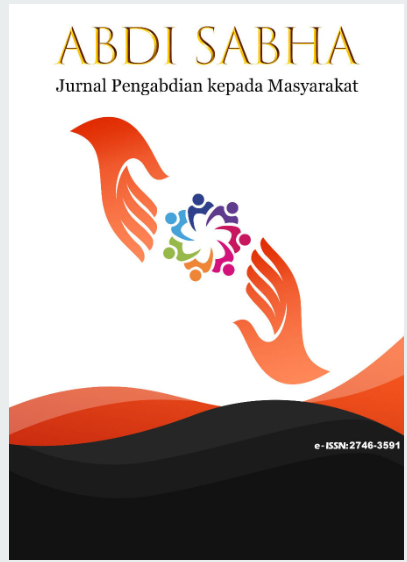Peningkatan Kebugaran Jasmani Melalui Gerakan Senam Ritmik Anak Indonesia Untuk Atlet Disabilitas National Paralympic Committee
DOI:
https://doi.org/10.53695/jas.v6i2.1314Keywords:
Physical Fitness, Disability, Rhythmic Gymnastics, Athlete TrainingAbstract
This training program aimed to improve the physical fitness of disabled athletes under the National Paralympic Committee (NPC) of North Sumatra Province through the application of Indonesian rhythmic gymnastics for children. The training method was adaptive and inclusive, tailored to the type and degree of each athlete’s disability. Conducted over several weeks, the program focused on enhancing muscular strength, flexibility, motor coordination, and athlete confidence. The results showed significant improvements in physical fitness indicators, marked by increased stamina, body flexibility, and enthusiasm in training. The program also boosted the athletes’ motivation and readiness to compete in the 17th National Paralympic Week (PEPARNAS) in 2024, held in Solo, Central Java. This training has proven that a culturally rooted approach such as Indonesian rhythmic gymnastics can serve as an effective alternative in coaching programs for athletes with disabilities. It is expected that this model can be replicated in other regions as part of the broader development of disability sports in IndonesiaDownloads
References
Amelia, Chairunnisa, and Indah Pratiwi. "Pelatihan Pembuatan Alat Permainan Edukatif Bagi Guru TK Al-Munawwaroh Dan TK Dewantara." Ihsan Jurnal Pengabdian Masyarakat (2021): 238-243.
Aznan, E., Ismail, A. D., Kassim, A. F. M., Yusof, M. K. M., & Samat, H. A. (2022). Accessibility of Fitness Facilities and Physical Activity Participation: A Comparison of Disabled Athletes and Disabled People. Jurnal Intelek, 17(1), 16040.
Anderson, L. S., & Heyne, L. A. (2021). Physical activity for children and adults with disabilities: An issue of "amplified" importance in the COVID-19 era. Disability and Health Journal, 14(2), 101089.
Banta, J. (2001). Athletics for people with disabilities. Developmental Medicine & Child Neurology, 43, 56-56.
Blauwet, C., & Willick, S. E. (2019). The Paralympic Movement: Using Sports to Promote Health, Disability Rights, and Social Integration for Athletes With Disabilities. PM&R, 11(3), S237-S248.
Côté-Leclerc, F., Boileau Duchesne, G., Bolduc, P., Gélinas-Lafrenière, A., Santerre, C., Desrosiers, J., & Levasseur, M. (2017). How does playing adapted sports affect quality of life of people with mobility limitations? Results from a mixed-method sequential explanatory study. Health and quality of life outcomes, 15(1), 22.
Dowling, S., McConkey, R., Hassan, D., & Menke, S. (2020). Promoting social inclusion thugh Unified Sports for youth with intellectual disabilities: a five- nation study. Journal of Intellectual Disability Research, 54(4), 923-935.
Fadaei-Dehcheshmeh, M., & Shamsi-Majelan, A. (2019). Comparison of Physical Fitness in Persons with Intellectual Disability with and without Experience of Special Olympics Iran. Journal of Research in Rehabilitation Sciences, 14(3), 175-182.
Hasan, M. A., Muslim, M. R., Baid, M. F., & Siregar, I. K. (2025). Optimalisasi Layanan Bimbingan Konseling Inklusif sebagai Upaya Peningkatan Kesejahteraan Sosial Masyarakat Desa Bongo. ABDI SABHA (Jurnal Pengabdian Kepada Masyarakat), 6(2), 87–97.
Jaarsma, E. A., Dijkstra, P. U., Geertzen, J. H., & Dekker, R. (2018). Barriers to and facilitators of sports participation for people with physical disabilities: A systematic review. Scandinavian Journal of Medicine & Science in Sports, 28(2), 327-342.
Keegan, R. J., Harwood, C. G., Spray, C. M., & Lavallee, D. (2019). A qualitative investigation of the motivational climate in elite sport. Psychology of Sport and Exercise, 10(1), 109-119.
Keogh, J. W., & Winwood, P. W. (2017). The epidemiology of injuries across the weight-training sports. Sports medicine, 47(3), 479-501.
Levine, B. (2019). Designing Sport Specific Physical Fitness Programs for Students with Developmental Variations.
Marks, B., Sisirak, J., Heller, T., & Wagner, M. (2010). Evaluation of community-based health promotion programs for special olympics athletes. Journal of Policy and Practice in Intellectual Disabilities, 7(2), 119-129.
Martin, J. J. (2020). Handbook of disability sport and exercise psychology. Oxford University Press.
Misener, L., & Darcy, S. (2022). Managing Paralympic Sport: Principles and Practices. Routledge.
Rintala, P., Asunta, P., Lahti, J., & Loovis, E. M. (2016). Physical fitness of individuals with intellectual disability who have Special Olympics experience.
Roux, C. J. (2020). Adapted physical activities and sports for persons with disabilities: Conceptual and practical considerations. African Journal for Physical Activity and Health Sciences, 26(1), 122-135.
Sahlin, K. B., & Lexell, J. (2018). Impact of Organized Sports on Activity, Participation, and Quality of Life in People With Neurologic Disabilities. PM&R, 10(6), 618-624.
Schilling, M., Coles, R., & Ekonen, D. (2015). Effects of Special Olympic Training on the Physical Health of Individuals with Intellectual Disability.
Shapiro, D. R., & Martin, J. J. (2020). The relationships among sport self-perceptions and social well-being in athletes with physical disabilities. Disability and Health Journal, 3(3), 176-181.
Siregar, E. F. S., Sari, S. P., & Nasution, I. S. (2022). Pelatihan Dan Pendampingan Guru Sekolah Dasar Dalam Menyusun Media Inovatif Berbasis Screencast O Matic Di Masa Pendemi Covid-19. Martabe: Jurnal Pengabdian Kepada Masyarakat, 5(1), 56-62.
Smith, B., & Sparkes, A. C. (2022). Routledge handbook of qualitative research in sport and exercise. Routledge.
Tweedy, S. M., Mann, D., & Vanlandewijck, Y. C. (2021). Research needs for the development of evidence-based systems of classification for physical, vision, and intellectual impairments. Journal of Sport and Health Science, 10(2), 148-157.
Válková, H. (2016). Sports Training within Special Olympics Fitness Innovation Program.
Additional Files
Published
How to Cite
Issue
Section
License
Copyright (c) 2025 ABDI SABHA (Jurnal Pengabdian kepada Masyarakat)

This work is licensed under a Creative Commons Attribution-NonCommercial-ShareAlike 4.0 International License.





